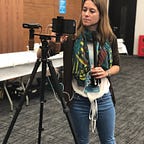MoJo is innovating as an audiovisual journalist
Mobile Journalism has come to stay, nobody doubts it. Me neither, as it is what I do for a living. It’s been a year and a half already. I can tell that after nearly 10 years working on several national tv stations I ended up happily freelancing in the best way I knew and my smartphone was the key to it.
Mobile Journalism has little history yet, but it seems to me it has a great future ahead. Big media companies such as the BBC have seen the gold mine and have introduced the smartphone as a key tool to produce their news content.
But how a single journalist can make the change?
After my maternity leave of my second child I thought I wanted to be able to have more family time and the best way I could possibly do so was freelancing. As my journalistic experience was strongly stuck to the creation of audiovisual content I started figuring out how I could create videos without having to spend a whole lot of money in equipment and personnel. Also, my husband and I had cristal clear that my professional return had to make an impact so that it could be fast and profitable.
Choosing the smartphone as my precious one and only tool wasn’t random. My husband, Pablo Fernádez-Maquieira, and my cousin Iago Fernández-Cedrón, had funded a tech startup called Videona a couple of years ago whose principal activity was developing apps that help create video content with mobile devices.
After that, you know how this sometimes comes rolling over, I came to know that one of my former bosses had founded a digital newspaper, Hispanopost, that was embracing #MoJo as the way of telling compelling stories. It was then when I really started moving onwards to what today is my business.
At first I had to make myself with other helpful equipment such as microphones, a gear and a tripod, so that the quality of my videos was as professional as it could possibly be. Besides, I started using one specific editing tool Videona was making specially for us journalists called ViMoJo. So useful, so handy, so appropriate. I could actually record, edit and launch my videos into my social networks in a glimpse. Also to my clients.
As simple as that, I thought. But of course, I still had to refresh all my knowledge about sound recording, image stabilizers and editing. But even though this could sound a bit technical has actually been very practical and entertaining. At least that is what I think.
Not late after that, I started video blogging. I found that #MoJo gave me the freedom I needed to tell the stories I wanted, and how I wanted them. Right now my creativity has no limits.
I have tried several editing tools by now. Luma, Kinemaster, IMovie and Storyteller. But my best options are clearly ViMoJo and Kinemaster. Easy, intuitive and with very professional results.
What about newsrooms?
Globally, I am certain that #MoJo enriches newsrooms because it helps create high quality audiovisual content with an affordable cost and with a very simple learning curve for those journalists who have no audiovisual background. Some professionals say smartphones are just an extension of ourselves, and maybe they are. Or we are just optimizing their capability a bit more.
As I mentioned earlier, Senior BBC Cameraman Duncan Stone, explained all about the experiment taking place in the BBC newsroom to Glen Mulcahy, one of the founding fathers of MoJo and responsible for MoJoFest, the Mobile Journalism Festival. This is what he said.
The key to this is that the consumption of video nowadays is tremendous and continuously growing. Up to 58% of the audiovisual content created in the first trimester of 2018 was viewed on smartphones, three times more than it did in the same period of 2017. So as media slowly realizes how to implement video production in their newsrooms we journalists need to be prepared for the future. Are you?
